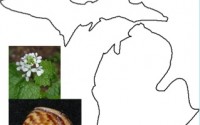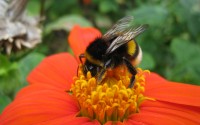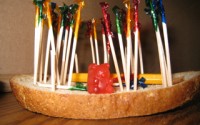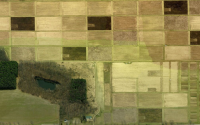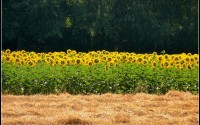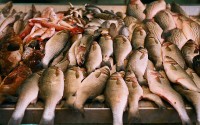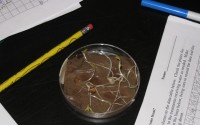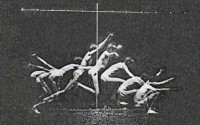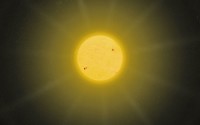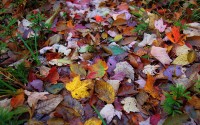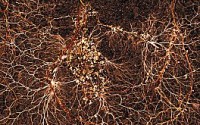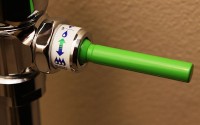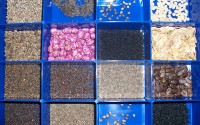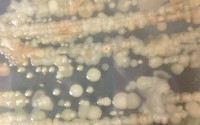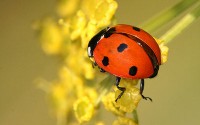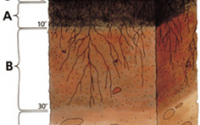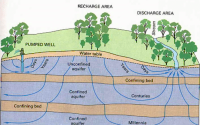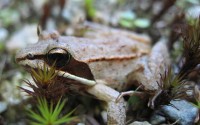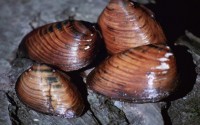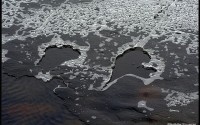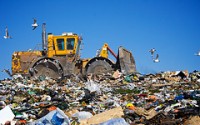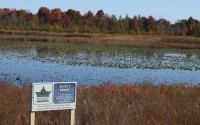Using a critical reading exercise and discussion, students will explore the perceptions and realities of sex differences in behavior, the causes of these differences. They will then use spotted hyenas, an unusual African mammal with a primate-like social system, to explore how scientists learn about individual and sex differences in aggressive behavior. The lesson will end with an activity that allows students to act as behavioral researchers. The lesson can be divided into three portions which can easily be made to stand alone, so teachers can do any and all portions as time permits. At the conclusion of the lesson, students will be able to: Read science presented in the media with a critical eye Consider the causes of variation in animal and human aggression Become more familiar how scientists study behavior Learn about current research in spotted hyena behavior […]
Survivor: Extreme Environments: How invasive plants outwit, outplay and outlast their competitors
This lesson plan provides a simple introduction to the mechanism of natural selection for students who are already familiar with concepts such as ecosystems, species, and variation. The lesson includes a short walk (can be done with nature photos) to identify the types and scales of variation in the natural world. Students then work in groups to adapt organisms (seeds) to different environments (soil types) in a fun, interactive exercise. Once seeds are well adapted to their environments, students will try to determine what made some of the organisms better than others, and try to predict how a new seed type will fare. The entire lesson is framed around how adaptions may help invasive species, but is equally applicable to native species. Teacher scripts are provided for the lesson introduction and accompanying power point. This lesson would be appropriate in […]
Michigan’s Most Unwanted: How to identify Michigan’s invasive species and why we should worry
How do we identify invasive species, and why do we care? In this lesson, students learn to make and use dichotomous keys to identify common invasive species. Students will gain an appreciation for why invasive species are important through a series of discussions, videos, and keying activities. A graphing activity will allow students to make graphs, interpret data from graphs, and draw conclusions based on data. At the conclusion of the lesson, students will be able to: Make and use simple dichotomous keys to identify species Discuss why species identification skills are important to understanding and preventing invasion. Convert a data table into a figure and draw conclusions Interpret a figure and discuss ecological explanations for the data shown Resources: Lesson plan Powerpoint presentation Graphing Activity (worksheet) Jelly Bean Key News Article 1 News Article 2 Lesson Plan created by […]
What’s the Buzz?
Students will learn the common types of pollinators. They will then learn the characteristics of flowers that allow the flowers to attract and utilize particular pollinators. Students will then go outside to put their predictions to the test by observing plants and their pollinators. At the conclusion of the lesson, students will be able to: learn some of the common types of pollinators notice more details of plants with which they come into contact be able to predict what might pollinate each plant species learn that even though flowers look very different from one species to another, they still share some characteristics that allow them to be pollinated by similar types of pollinators Resources: Lesson plan (.doc) Presentation (.pdf) Worksheet (.doc) Lesson Plan created by GK-12 Fellow Raffica La Rosa, 2008
Forest of Fortune
Students explore the natural areas that are managed around Michigan (e.g. forests, lakes, rivers, prairies). Students will learn about the needs of the many interest groups that managers must satisfy when making a management plan. Students will then become National Forest managers of mini-stands in order to simulate the decisions that need to be made when creating a management plan and some of the unpredictable events that take place At the conclusion of the lesson, students will be able to: Name the types of natural areas that are managed in Michigan (and elsewhere) List examples of considerations (interest groups, funding, policy etc.) that managers need to satisfy when creating a management plan Describe the relationship between profitability and sustainability Discuss some techniques that are used for management of forests Resources: Lesson plan (.doc) Presentation (.pdf) Student worksheet (.doc) Student worksheet – elementary (.doc) World-view […]
How Do Scientists Study Succession?
KBS scientists maintain 4 different types of successional plots: two get tilled every year and two have been undisturbed since 1988. One of the tilled and one of the untilled plot get fertilized with nitrogen, an important nutrient limiting plant growth, every year; the other two plots do not. Each year, scientists collect data on which plant species are there, how much they grow, and other characteristics of the plants. In this lesson, students will explore this data to learn about succession, human disturbance (tillage), plant traits, plant life history, and population growth. They will also gain scientific skills in graphing and math. At the conclusion of the lesson, students will be able to: Work with a real data set from the KBS LTER Understand how management regimes can influence communities Have a good understanding of using Microsoft Excel to […]
Light and Plant Biomass
Tracing matter and energy through environmental ecosystems: in specific, how plant production of organic carbon (biomass) is related to availability of an essential resource for photosynthesis (light). Do taller plants produce more biomass than shorter plants? How are plant height and stem density related to the amount of light reaching the ground? At the conclusion of the lesson, students will be able to: measure plant biomass in relation to light availability at the soil surface examine soil and roots draw conclusions about how aboveground biomass, plant height, stem density, and light availability are related Resources: Lesson plan (.doc) Introduction (.pdf) Outline of lesson (.doc) Datasheet (.doc) Lesson created by Emily Grman and Sue Zygadlo, 2008
To Fish or Not To Fish
Students explore sustainability of seafood consumption through modeling harvest rates in an Excel file and debating the relative costs and benefits of farmed vs. wild-caught fish. Provided with information on the various direct and indirect human impacts of both fishing and fish farming and assigned a position, teams of students will construct argument for their position and use data to support their conclusions. At the conclusion of the lesson, students will be able to: Understand that there are costs and benefits of human impacts and to provide examples of each. Understand and be able to describe the magnitude of human disturbances. Define environmental sustainability and make an argument for whether it should be an important consideration in our behavior. Resources: Lesson plan (.doc) Human impact in aquatic systems presentation (.pdf) Student worksheet (.doc) Exercise (.xls) Debate positions (.pdf) Debate ammunition (.pdf) Evaluation (.doc) Lesson created by GK-12 […]
Where does plant mass come from?
Students will learn the products and reactants of photosynthesis and respiration. They will generate a circular diagram showing the cycle of carbon through carbon dioxide and sugars (the hypothesis). They will generate predictions from this hypothesis that refer to specific treatments in the experiment they will set up. They will set up an experiment with germinating bean seeds in petri plates (with or without water, in the light or in the dark), collect data over two weeks, and analyze the results graphically and verbally. At the conclusion of the lesson, students will be able to: Explain that respiration causes the loss of dry biomass (sugars) Explain that photosynthesis causes the gain of dry biomass Understand that carbon (carbohydrates) from carbon dioxide in the atmosphere makes up most of the dry mass of plants. Resources: Lesson plan (.doc) Outline of activities (.doc) Pre-assessment (.doc) […]
Animal Motion
* This lesson provides a link between the Living Organisms and Movement Battle Creek Area Math and Science Center units. Students explore the different ways animals move and name body parts used for locomotion. They also explore plant movement (seed dispersal) and discuss the fact that plants need help moving (being pushed by wind or water) whereas animals can move themselves. At the conclusion of the lesson, students will be able to: Identify body parts commonly used for animal movement Recognize that plants move when they are seeds Discuss reasons why plants and animals might want to move Resources: Lesson plan (.doc) Lesson created by Emily Grman
Albedo: How much of the sun’s energy gets absorbed?
Students will explore how different substances (air, water) and different colors absorb energy from the sun and warm up. We will discuss what we already know about light energy and absorption, make predictions about what color of background paper will cause air and water to heat up faster, test our predictions by constructing boxes and collecting temperature data, analyze our data, and make conclusions about the implications for climate change. At the conclusion of the lesson, students will be able to: Graph data and interpret graphs Draw conclusions from data collected during an experiment Understand that the energy that powers almost everything on the planet comes from the sun, and that different substances can absorb more or less of that energy Resources: Lesson plan (.doc) Presentation (.pdf) Student worksheet (.doc) Worksheet for 2nd try (.doc) Figures (.xls) Lesson created by Emily Grman, 2009
Into Thin Air: What happens to leaves when they decompose?
Middle school Students will expand on their understanding of carbon cycling by measuring the concentration of CO2 and O2 in sealed containers with decomposing leaves. Students will gain experience using the Vernier LabQuest system with two gas sensors. They will also graph data and use the data to evaluate their predictions about what will happen to the carbon inside leaves. At the conclusion of the lesson, students will be able to: Understand that most of a leaf’s mass goes into the air during decomposition Recognize the six major elements making up living tissue Understand why decomposition is a central step in carbon cycling. High school Students will expand on their understanding of carbon cycling and decomposition by measuring the concentration of CO2 over time in closed containers with decomposing materials. In Part 1, they will set up coffee cans in […]
Mycorrhizae: Mutualism or Parasitism?
Students will explore one example of a symbiosis (mycorrhizae) and examine whether it is a mutualism or a parasitism. They will review the life requirements of producers (plants) and consumers (mycorrhizal fungi) and play a game simulating trade between the two organisms in two different environments. At the conclusion of the lesson, students will be able to: Define symbiosis, mutualism, parasitism, consumer, producer Explain how plants and mycorrhizal fungi obtain their life requirements (air, food, water) Understand that changes in the environment, including changes caused by humans, can change the way organisms interact Resources: Lesson plan (.doc) Student worksheet (.doc) Answer key (.doc) Figures (.xls) Lesson created by Emily Grman, 2009
Invisible Friends Underground
In an inquiry-based activity, students will learn about mycorrhizal fungi and how to find them by collecting roots, staining them with ink and vinegar, and looking for fungi under the microscope. At the conclusion of this lesson, students will be able to: Use a microscope Prepare wet-mount samples Understand one example of a mutualistic interaction and how it can change depending on the environment Formulate research questions Make predictions about what will affect the abundance of a specific type of organism and collect data to test their predictions Make and interpret graphs of data Resources: Lesson plan (.doc) Introduction presentation (.pdf) Student worksheet (.doc) Photo sheet (.pdf) Lesson plan created by Emily Grman, 2012
Humans and Biodiversity
This lesson explores potential impacts that humans have on biodiversity as well as defining biodiversity, and exploring the potential positive impacts it has on humans and ecosystems. The lesson includes an outdoor activity consisting of choosing and visiting three sites that span a gradient of human impact. Using data collected during this activity, students will learn to use these data to calculate indexes of biodiversity. Some time will be spent discussing benefits/drawbacks to the methods employed. Data from the three sites will be compared to explore how humans tend to affect biodiversity. The topic of genetic biodiversity will also be covered with some examples where genetic diversity is important for humans and ecosystems. At the conclusion of the lesson, students will be able to: Assess levels of biodiversity in a given habitat Discuss benefits and drawbacks of different methods for […]
Rotten, but not forgotten
Students often have misconceptions about the process of decomposition. Students often explain decomposition as a purely physical process. This introductory activity is meant to display the biochemical process of cellular respiration as it is occurring in microorganisms present in composting material. Cell respiration refers to the process of converting the chemical energy of organic molecules into a form immediately usable by organisms. Glucose may be oxidized completely if sufficient oxygen is available according to the following equation: C6H12O6 + 6O2 –> 6 H2O + 6 CO2 + energy All organisms oxidize glucose for energy. Often, this energy is used to convert ADP and phosphate into ATP. Using the CO2 Gas Sensor and O2 Gas Sensor, students will monitor the carbon dioxide produced and the oxygen consumed by bacterial and fungi during cell respiration. Resources: Activity plan using CO2 and O2 Vernier […]
Conserving water and calculating your water footprint
Students will record their own water usage at their house for a week and estimate their daily water consumption. They will then be re-assigned to a different country where their water will be limited to the average usage of people in that location. The students will have to decide what they will use their allocation of water for, and then listen to how much other groups got to use and what they chose to use their water for. At the end, we will brainstorm why some locations have more water to use than others, and how that can lead to conflicts among different groups. At the conclusion of the lesson, students will be able to: Identify wasteful water practices Explain differences in water usages in different areas Understand the impact that water availability has on society Resources: Lesson plan (.doc) Presentation (.pdf) […]
Succession: patterns in the field and in seeds
This lesson will review what the students already know about succession, then develop their understanding of what may be driving the pattern. They will brainstorm hypotheses and predictions. They will walk the nature trail to practice recognizing different successional stages and to collect seeds from the plants in different stages. They will also think about seed dispersal and other plant adaptations. This lesson can be expanded to include a section where 10th grade students give 5th grade students a tour of the nature trail and teach them about succession. At the conclusion of the lesson, students will be able to: Recognize successional patterns in plant communities in the field Recognize seeds and the structures in which they occur; describe the dispersal adaptations of those plants Brainstorm hypotheses explaining succession and generate predictions Resources: Lesson plan (.doc) Presentation with background information (.pdf) Drawing […]
From Molecules to Populations: Describing Diversity Using Molecular Tools
Ever wonder how biologists reconstruct ancient human migrations? Or, how a paternity test works? It’s all in the genes, folks! Our session will focus on the many practical applications of molecular biology. Building on the Lady Beetle Blitz session, we’ll describe variation in field collected beetles, categorizing them based on phenotype, and then use molecular tools to reconstruct their North American Invasion in the late 1980s. At the conclusion of the lesson, students will be able to: Describe the diversity of a population in terms of phenotype and genotype. Use genotypic information to answer questions about the migration of a species. Use genotypic information to answer evolutionary questions about organisms. Resources: Lesson plan (.doc) Handouts: Phenotype and genotype comparison (.doc) Genetic sequences (.doc) Lady beetle intro sequences (.doc) Mitochondrial DNA data and questions (.doc) (optional extension) Lesson Plan created by GK-12 Partners Robin Tinghitella and […]
Microbes on Trial: A Case for the Benefits Provided by Microbes in Ecosystems
Students will examine their preconceived notions about microorganisms. The intent is to focus on the benefits microorganisms provide in several diverse ecosystems. In the first part of the lesson students will use petri plates to grow microorganisms from various outdoor habitats. In the second part of the lesson students research various topics related to microorganisms and present their findings to the class. At the conclusion of the lesson, students will be able to: Describe the role of microbes in ecosystems Describe symbiotic relationships between microorganisms and other organisms Describe how microorganisms can change biotic and abiotic components of an ecosystem Resources: Lesson plan Lesson plan includes links to other resources Lesson Plan created by GK-12 Fellows
Lady Beetle Blitz
For this lesson, you will be participating in citizen science project started by Dr. Mary Gardiner at Ohio State University. Mary is a former graduate student in Entomology at Michigan State under the direction of Dr. Doug Landis. In 2009, approximately 100 Ohio gardeners will be collecting lady beetles on sticky traps and assessing populations of native and exotic species. All of the data will be compiled by Dr. Gardiner to assess the status of lady beetle populations across the state (http://ale.cfaes.ohio-state.edu/outreach/buckeye-lady-beetle-blitz-blbb). We are excited at KBS to expand this study into curriculum material that can be used in area K-12 classrooms to improve biodiversity literacy and provide an opportunity for cross district collaborations and partnerships between KBS teachers and other teachers nationally and/or internationally. Upon completion of this lesson, students will be able to: Identify lady beetles to the […]
The Subliminal Significance of Soil
This lesson will build participants’ understanding of the importance of soil food webs by directly measuring carbon dioxide production due to soil organism respiration in samples from a variety of habitat types. Differences between annual and perennial crop field soils, as well as those from forests and lawns, will be used to highlight the important differences in carbon storage rates among these soil types. The main activity will be a titration lab determining the CO2 production from soil microcosms caused by microbial respiration. A class demonstration using Vernier probes will measure the same variable as a comparative method. A brief introduction to global carbon cycling and soil ecosystem components will precede the lab work. Upon completion of this lesson, students will be able to: Measure CO2 production from soil respiration with at least two methods. Identify some of the major groups […]
Groundwater Conceptions and Processes
Teacher professional development lesson that can be modified for the classroom. This lesson about groundwater includes an overview of three important ideas: the scarcity of freshwater reservoirs available to us, what water looks like and how it flows in the ground, and how our land-use choices impact the availability of groundwater. First is a demonstration of what percentage of the Earth’s water is available to us. Incorrect conceptions of groundwater are very common, so we will use student drawings to understand where our students are starting when we introduce the idea of groundwater. Finally we will demonstrate groundwater movement and storage using small groundwater models that teachers can use in their classrooms. Upon completion of this professional development session, teachers will be able to: Demonstrate the relative amounts of water on the Earth that is in various reservoirs Pre-assess and […]
Gases matter!
When understanding the states of matter, students often are able to understand those states they can see and work with the easiest (liquids and solids), and they are less able to reason about gases. Gas is all around us, but most students don’t think it weighs anything or matters very much. This exercise is designed to help students realize that gas has mass, and that the gas can add up and affect how the world works. We will weigh a balloon empty and full to see how the gas weighs something. We will watch a glass of soda lose mass as the bubbles leave. We will then compare the temperature within two clear containers (one with classroom air, and the other with the breath of a student) that are placed in the sun to see how particular gases (in this […]
Frogsicles: how frogs survive the winter
How do frogs survive the winter when they’re frozen solid? Their heart may even cease to be beating, and yet they still bounce back just in time for some springtime hanky-panky. You will complete three short lab experiments to explore topics that help explain how frogs freeze over the winter: solute concentration, osmosis, and freezing point depression. At the conclusion of the lesson, students will be able to: Define and explain osmosis Predict the relative freezing points of pure water, salt water, and sugar water Understand that frogs have adaptations that help them survive the winter Resources: Lesson plan (.doc) Student worksheet (.doc) Lesson Plan created by GK-12 Fellows Emily Grman and Sara Parr Syswerda, 2008
You’re not you when you are hungry…
Students will explore their own level of assertiveness via a quick personality test to show that scores are not all the same in humans. Students will then do a manipulative simulation of her how individual variation can be maintained within a population by examining the survival and growth of bluegill that exhibit more aggressive and less aggressive foraging strategies. Students will do a behavioral lab experiment observing the behaviors of crickets in the presence or absence of food. Students will then be guided in creating their own inquiry experiment. At the conclusion of the lesson, students will be able to: Explain why intraspecific variation (individual variation within a population) can be maintained. (i.e. not always one best “adapted” trait) Learn how zoologists study behaviors of animals in varying contexts (crickets in the presence and absence of food). Create and carry […]
Don’t Shell Yourself Short
Students explore the effects of natural selection on populations with or without trait variation. Students play a game with nuts simulating crab-mussel interactions, gather data from the game, analyze it by making figures, and draw conclusions about how an introduced predator could cause quick evolutionary change in only a few generations of the prey species. Students answer questions about the three requirements for evolution by natural selection and discuss other examples of rapid evolution. At the conclusion of the lesson, students will be able to: List the three requirements for evolution by natural selection Phenotypic variation in a trait Relationship between that trait and fitness The trait must be heritable Determine whether evolution happened in a given situation Resources: Lesson plan (Word) Peanuts and almonds/pistachios (in the shell) Student worksheet (Word) Presentation (PDF) File to generate figures (Excel) Lesson […]
Comparison of Historical Lake Ice Cover Data From Three Lakes in Michigan and Wisconsin
What evidence do scientists really have to support global climate change? Students will explore long term datasets on the duration of ice cover for three different lakes (Gull Lake, Fair Lake, and Lake Mendota). They will examine patterns of variation at different time scales to see the importance of long-term data as well as the importance of having multiple sources of support for scientific hypotheses (in this case, global climate change). At the conclusion of the lesson, students will be able to: Interpret data Make inferences from trends or patterns in data Make spatial and temporal comparisons of ecological systems Explain how lake ice cover has changed due to global climate change on three lakes Resources: Lesson plan (.doc) Climate change presentation (.pdf) Student handout (.doc) Data files (simple, standard, teacher) (.xls) Access to computers with Microsoft Excel Lesson Plan created […]
Thinking About Waste
Waste generation in the U.S. is an enormous problem, as 230 million tons of trash is generated each year. Students must begin to learn about these issues because natural resource depletion and environmental degradation may directly affect their lives in the future. This lesson is designed to get students thinking about how to cut waste in their own lives. They will draw pictures of the Earth in 100 years under two different scenarios. They will also list some ways that the school and families at home can reduce waste, which will be posted in the school hallway. Students should come away from the lesson with a positive outlook, that waste generation can be significantly cut, which will benefit everyone in the world. At the conclusion of this lesson, students will be able to: Understand that an immense amount of waste […]
Volume of Snow and Water
Water and snow do not have the same volume because snowflakes have air pockets trapped inside. When snow melts, the air pockets are released to the atmosphere. In addition, water in the solid form has roughly 9% more volume than in the liquid form because of the way the molecules are bonded together via hydrogen bonds. Therefore, when snow melts, the volume of the water is reduced as air molecules are released and hydrogen bonds are broken. In this activity, students investigate the volume relationship between snow and water, which changes depending on the weather conditions at the time of a snow event and the amount of time since the snow event. Students will use many skills learned regarding making measurements of volume to accomplish this activity, and will understand how much liquid water comes from the snow in one […]
Land Conservation Debate
Photo Credit: Southwest Michigan Land Conservancy In 1980, 6% of Michigan’s landscape was covered by urban areas. Experts project that by 2040, 18% of the landscape will be developed into urban areas. This comes at a huge cost to natural landscapes including the ecosystem services they provide. In this activity, students will be divided up into groups that represent different landscapes including farmland, wetlands, forests, prairies and urban areas. Students in these groups will identify reasons and share arguments for protecting natural landscapes or developing areas for urban expansion. Students are allowed to debate the topic between groups and to come up with a reasonable solution to the problem of expanding urban development. Specific examples in the local community provide grounds to really understand how this plays out in the real world. At the conclusion of this lesson, students will […]



